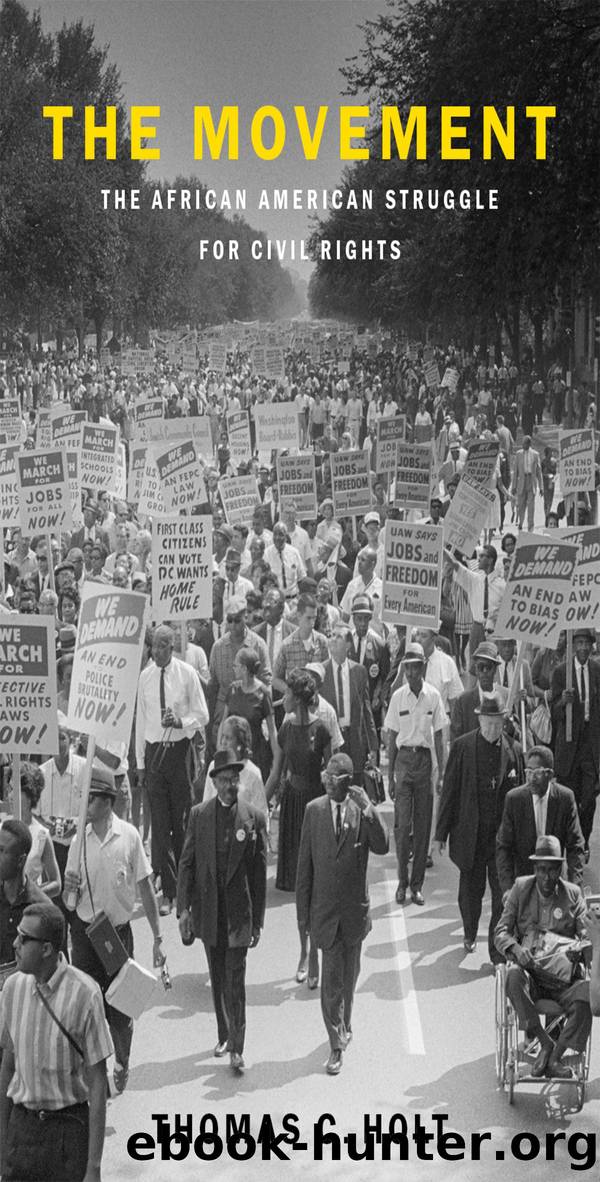The Movement by Thomas C. Holt

Author:Thomas C. Holt
Language: eng
Format: epub
Publisher: Oxford University Press
Published: 2021-06-15T00:00:00+00:00
A New Organizing Agenda
After their second meeting, in the summer of 1961, Moses followed up Mooreâs suggestion that he contact C. C. Bryant, the president of the NAACP chapter in McComb, a town in Pike County, near the Louisiana border and roughly eighty miles south of the state capital at Jackson. Thus, Mosesâs first major effort to register Mississippi voters began far from the Delta region that would later become the focus of SNCCâs Mississippi campaign and, ironically, in a region bearing place names like Lincoln and Lamar, which reflected its history in the last century when it was a hotbed of black Reconstruction politics. Moses began organizing a wary and vulnerable people by spending weeks simply listening to them. Only then did he try to prepare them to enter alienating courthouses and sheriffâs offices where they would confront confusing literacy tests administered by hostile registrars. After some encouraging initial successes, white resistance stiffened and violence erupted as the tempo of registration attempts quickened. In Liberty, Amiteâs ironically misnamed county seat, Moses was arrested and jailed while accompanying aspiring voters to the registrarâs office. Shortly afterward he was assaulted by the sheriffâs cousin and needed eight stitches to close a head wound. The local court found the sheriffâs cousin not guilty.10
Although his effort was eventually reinforced by the arrival of a dozen more SNCC workers, Mosesâs focus on canvassing voters was soon overtaken by the very different ambitions of the areaâs high school youth, who were determined to emulate the daring challenges to segregated lunch counters they had witnessed elsewhere. Much like Charles Sherrod and Cordell Reagon in Albany, therefore, the SNCC field workers found themselves drawn into supporting sit-ins that these young people launched at Woolworthâs and the Greyhound bus station. This and similar developments in Jackson delayed further progress in the registration campaign, especially when many of the students were expelled from school, which, in contrast with earlier campaigns, turned many of the parents against the Freedom Riders. The brutal murder in broad daylight of Herbert Lee by a state legislator eroded the communityâs support even further, effectively shutting down the project after just four months.11
The growing body count made clear that organizing the rural Deep South was a life-and-death decision. How peopleâordinary peopleâcame to make that decision was not a question to be taken lightly. This campaign would require different strategies and means of protecting both organizers and participants. The nonviolent discipline necessary during sit-ins and street demonstrations was useless in situations where violent attacks came from nightriders and assassins. Confronting such terrorism, local black communities eventually turned to armed self-defense to protect the activists as best they could.12
It was against this backdrop that the SNCC field staff had gathered at the Highlander center in August 1961 for a tense three-day debate over the future direction of their movement.13 The initial question was whether SNCC should shift its resources into voter registration projects, which many feared meant abandoning the direct-action campaigns that had defined the organization from its inception.
Download
This site does not store any files on its server. We only index and link to content provided by other sites. Please contact the content providers to delete copyright contents if any and email us, we'll remove relevant links or contents immediately.
| Administration & Medicine Economics | Allied Health Professions |
| Basic Sciences | Dentistry |
| History | Medical Informatics |
| Medicine | Nursing |
| Pharmacology | Psychology |
| Research | Veterinary Medicine |
Bioenergetica by Alexander Lowen(1122)
Noise: A Flaw in Human Judgment by Sunstein Cass R. & Sibony Olivier & Kahneman Daniel(968)
The Data Detective by Tim Harford(940)
The Child in You by Stefanie Stahl(882)
Chatter by Ethan Kross(797)
The Science of Rapid Skill Acquisition by Peter Hollins(637)
Freedom by Sebastian Junger(630)
No Bad Parts by Richard C. Schwartz(600)
The Montessori Baby by Simone Davies(561)
Evolution Gone Wrong: The Curious Reasons Why Our Bodies Work by Alex Bezzerides(559)
The Quantum Psychiatrist: From Zero to Zen Using Evidence-Based Solutions Beyond Medication and Therapy by Biswas Dona(551)
Maps of Meaning: The Architecture of Belief by Jordan B. Peterson(548)
The Science of Self-Learning: How to Teach Yourself Anything, Learn More in Less Time, and Direct Your Own Education (Learning how to Learn Book 1) by Peter Hollins(519)
Anxiety For Dummies by Charles H. Elliott & Laura L. Smith(512)
Sadomasochism and the BDSM Community in the United States by Stephen K. Stein(497)
Disconnected by thomas Kersting(480)
Why Sex Doesn't Matter by Olivia Fane(480)
The Mechanics of Passions: Brain, Behaviour, and Society by Alain Ehrenberg(480)
Jung - The Key Ideas: Teach Yourself (TY Philosophy) by Ruth Snowden(467)
